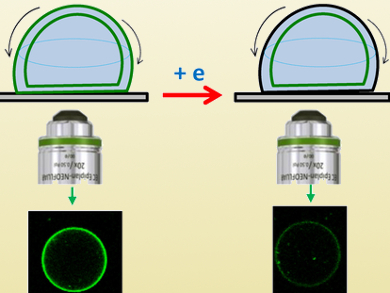Measuring the dynamic properties of lipid membranes has been previously achieved using a variety of fluorescence-based techniques. One such method is fluorescence loss in photobleaching (FLIP), in which the fluorescence intensity in one region is monitored during the continuous bleaching of another region in the sample.
Although photobleaching has been effectively used in biological samples, the high laser intensity needed for bleaching may affect cellular processes. Moreover, limitations in optics prevent researchers from discriminating between the two leaflets of a bilayer, which are asymmetric in biological samples, and therefore may exhibit different dynamic properties.
Olivier Buriez, École normale supérieure, Paris, France, and colleagues formed asymmetric giant vesicles containing 5 mol% of the fluorescent lipid N-(7-nitrobenz-2-oxa-1,3-diazol-4-yl)-1,2-dipalmitoyl-sn-glycero-3-phosphoethanolamine (NBD-PE) from oil/water interfaces. The team then deposited the vesicles on functionalized glass coverslips (pictured). The coverslip has a thin coating of conductive materials (indium tin oxide and gold) as well as biotin. Using their setup, the team was able to electrochemically bleach the bottom part of the giant vesicle, while monitoring the fluorescence intensity at the equator using confocal microscopy.
This technique, called fluorescence loss in electrochemical bleaching (FLIE), was used to calculate the diffusion coefficient of NBD-PE (4 μm2/s), which is in agreement with other techniques. Notably, FLIE was able to bleach the NBD-PE in the outer leaflet of the giant vesicle without affecting the inner leaflet. This technique allows to discriminate and separately characterize the two leaflets of lipid bilayers, which might make it an invaluable tool in cellular biology and biophysics.
- Selective Electrochemical Bleaching of the Outer Leaflet of Fluorescently Labeled Giant Liposomes,
Ana Isabel Perez Jimenez, Lylian Challier, Eric Aït-Yahiatène, Jérôme Delacotte, Eric Labbé, Olivier Buriez,
Chem. Eur. J. 2017.
DOI: 10.1002/chem.201605786



